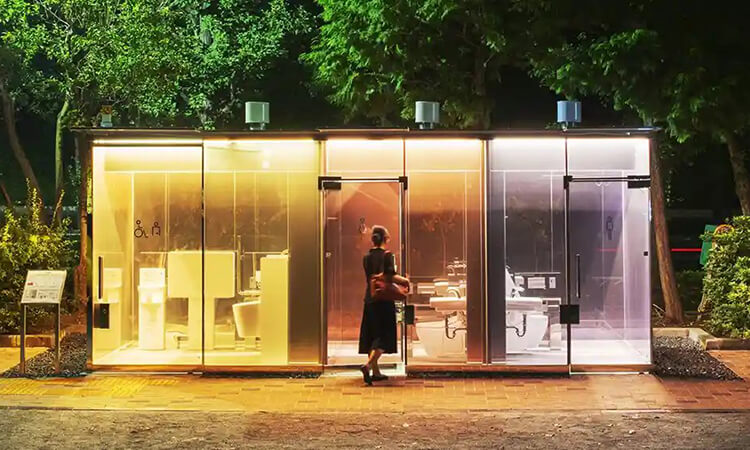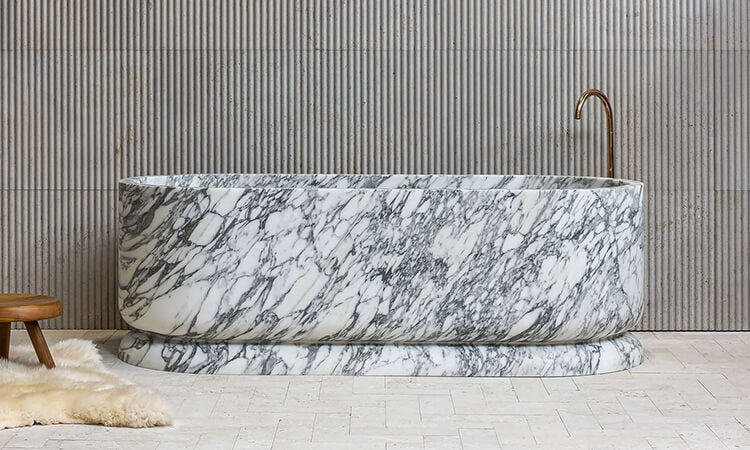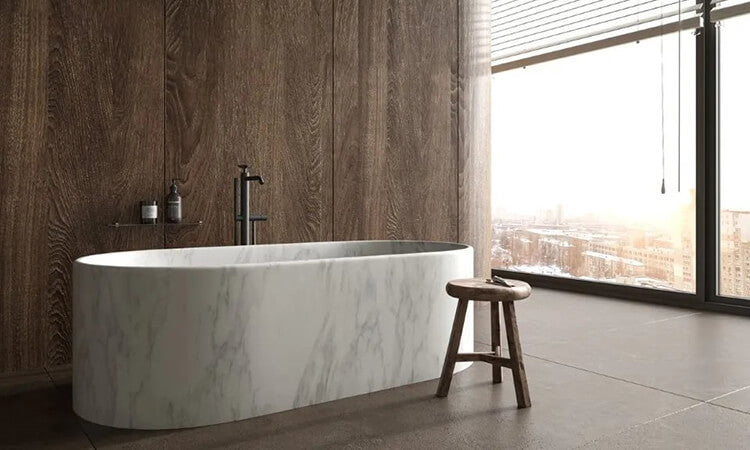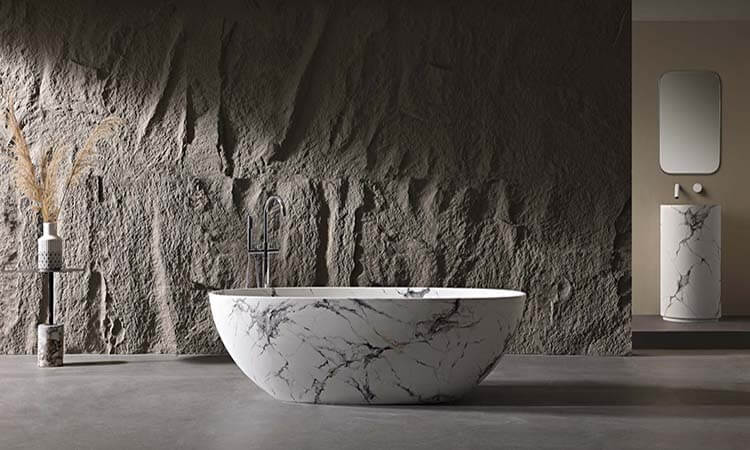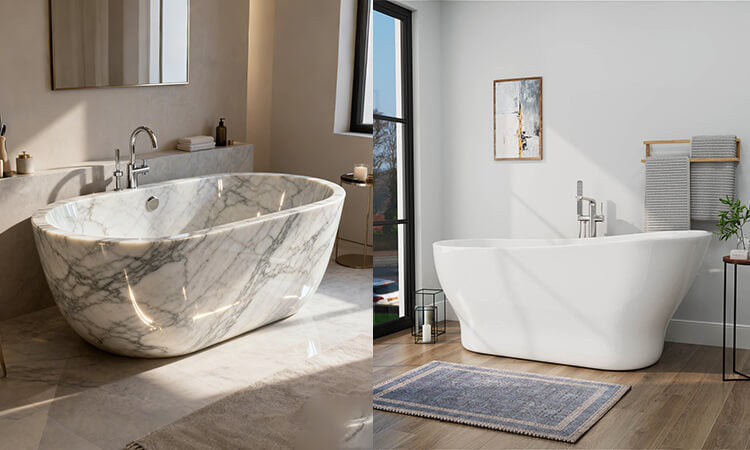When people think of marble bathtubs, two words usually come to mind: luxury and expensive.
A single natural marble tub—about 5.5 feet long—can easily run anywhere from $5,000 to $15,000, sometimes even more than what many homeowners spend on an entire bathroom remodel.
By comparison, a solid-surface bathtub of the same size might cost only a third of that, while acrylic tubs can be as little as one-tenth of the price.
So, what makes marble tubs so expensive? Is it just the cost of the stone itself, or is there something deeper behind the price tag?
Let’s take a closer look at what really drives the cost—from the rarity of raw materials to the skilled craftsmanship and complex installation—that makes marble bathtubs one of the most premium features you can add to a bathroom.
1. Raw Materials: The Rarity and Cost of Natural Stone
The high price of a marble bathtub starts with its very foundation — the stone itself. Natural marble is rare, expensive to source, and inherently difficult to work with, setting a steep baseline before any crafting even begins.
Formed over millions of years as limestone is compressed and heated deep within the earth, marble is one of nature’s most luxurious building materials. But not all marble is created equal. High-end varieties — such as Carrara White from Italy, Volakas White from Greece, or Turkish Grey Onyx — come from limited quarries that are heavily regulated for both environmental and extraction reasons.

Take Carrara marble as an example. It’s sourced exclusively from a small region in Tuscany, where annual extraction is limited to around 500,000 tons. Yet, only about 5% of that meets the purity, color consistency, and structural standards required for something as demanding as a freestanding bathtub. Those pristine, uniform blocks — free of cracks or mineral streaks — are what drive prices sky-high.
A single premium-grade Carrara marble block can range from $800 to $1,200 per cubic yard, while more common marble typically costs just $200 to $400. And to carve a full-size tub, the block has to be not only flawless but also large enough — usually at least 6.5 feet long, 3 feet wide, and 8 inches thick. These “Grade A” slabs are incredibly scarce and can cost three to five times more than standard blocks.
The quarrying process itself adds another layer of expense. Extracting marble isn’t as simple as cutting stone — it requires diamond wire saws, precision planning, and careful handling to prevent fractures. Each cut must be strategically mapped to preserve the integrity of the material. The specialized equipment alone — saws, cranes, loaders — can cost millions, and for every one cubic yard of usable marble extracted, three to five cubic yards often end up as waste.
By the time a suitable block reaches a fabricator, the combined cost of raw stone, quarrying, and transport can already hit $1,500 to $3,000 — more than the total retail price of an average acrylic bathtub.
2. Craftsmanship: The Time and Skill Behind Every Curve
Unlike acrylic or solid-surface tubs that can be mass-produced from molds, every marble bathtub is a one-of-a-kind creation — hand-carved, shaped, and polished from a single block of stone.
Selection and Cutting: Precision Down to the Millimeter
The process begins long before a single cut is made. Skilled artisans must first examine the raw marble block — studying its grain flow, veining direction, and color consistency — to decide exactly how to position the tub within it.
Even a tiny misjudgment can ruin the natural pattern, turning an entire block of stone into costly waste.
Cutting is done with high-precision CNC machines, accurate to within 0.02 inches (0.5 mm). Each rough form is intentionally cut two to four inches larger than the final dimensions, allowing room for grinding and refinement.
This stage alone can take 8 to 12 hours, and about 10% of blocks are rejected after the first cuts reveal hidden cracks.
Grinding and Polishing: Where Stone Becomes Silky
Once the rough shape is formed, the true craftsmanship begins. Turning a coarse stone block into a surface that feels smooth and inviting is a meticulous, multi-stage process: rough grinding, fine grinding, precision sanding, and final polishing.
Each phase is done mostly by hand, giving the craftsman full control over the stone’s texture and natural shine.
- Rough grinding removes saw marks and levels the surface — about 4 to 6 hours.
- Fine grinding refines the texture down to under 5 microns — another 6 to 8 hours.
- Precision sanding brings out the marble’s subtle sheen — roughly 8 to 10 hours.
- Final polishing, using wool wheels and specialized compounds, gives it that signature glossy glow — 10 to 12 hours.
Altogether, 30 to 40 hours of careful polishing go into every tub. Too much pressure can dull the finish; too little, and the luster won’t shine through.

Sealing and Quality Testing: The Invisible Finishing Touch
Even perfectly polished marble isn’t naturally waterproof. Its tiny pores must be sealed using premium stone sealants, usually imported, to prevent stains from soap, oils, or bath products.
The sealant is applied evenly across every surface, left to cure for 24 hours, and then buffed to achieve a natural finish.
Before shipment, each marble bathtub undergoes rigorous quality checks:
- Inspecting for scratches or uneven shine
- Verifying dimensions with ≤1mm tolerance
- Conducting a 24-hour water retention test to ensure there’s no leakage or hidden fractures
From start to finish, crafting a marble tub can take 15 to 20 days — compared to just one or two days for a molded acrylic bathtub. That difference in time, skill, and human touch is what truly sets marble apart — and why it commands such a premium.
3. Installation & Transport: The Hidden Final Cost
Unlike lightweight acrylic or resin tubs that two people can easily maneuver, a marble tub demands special logistics, reinforced flooring, and expert installation — all of which quietly add thousands to the total project cost.
Weight and Handling: Moving a Ton of Elegance
A standard full-size marble bathtub typically weighs between 900 and 1,300 pounds. That’s not something you can just carry up a staircase or fit through a tight doorway without meticulous planning.
Each move requires custom wooden crates, lifting straps, hydraulic dollies, and sometimes even compact cranes — especially for multi-story homes or high-end condos.
Before delivery, professional installers often perform an on-site assessment weeks in advance. They’ll evaluate whether your floor can handle the load (most standard residential floors can’t without reinforcement), measure doorways and hallways, and map out a delivery path to avoid sharp corners or delicate finishes.
Depending on distance, building type, and complexity, transportation and installation can add $800 to $3,000 to the total price. These hidden costs often get overlooked when shoppers compare tubs online — but they’re a very real part of what makes owning a marble bathtub a true luxury experience.
Floor Reinforcement and Plumbing Adjustments
A marble tub isn’t something you can just “place and fill.” Its tremendous weight often requires floor reinforcement, especially in homes with wood-joist subfloors or second-story bathrooms.
Contractors may need to add extra joists, steel framing, or additional subfloor layers, which typically adds another $500 to $1,500 to the overall project.
Precise plumbing alignment is another challenge. The drain and overflow openings in a marble tub are pre-cut, and because the stone can’t be easily altered once carved, every connection must be measured and prepared with millimeter-level precision before the tub is set in place.
A small misalignment could mean expensive rework — or worse, cracks in the stone. That’s why only experienced installers handle high-end marble tubs.

Finishing Touches: On-Site Polishing and Sealing
Even after installation, the finishing process isn’t over. Installers often perform final polishing and sealing on-site to remove micro-scratches from handling and ensure the surface maintains its signature mirror-like glow.
This last step enhances marble’s natural ability to reflect light softly across the bathroom, creating that unmistakable sense of depth and luxury.
4. The Intangible Value: Luxury Beyond the Price Tag
Aesthetic Harmony and Emotional Warmth
Every slab of marble holds its own natural history — veins that flow like frozen rivers, and subtle gradients that feel both organic and intentional. When that stone is sculpted into a bathtub, it becomes more than a fixture; it becomes a living piece of art that transforms an ordinary bathroom into a personal retreat.
Even though marble feels cool against the skin, it brings emotional warmth to a space. There’s something grounding about it — a sense of connection to nature, craftsmanship, and permanence. A luxury marble bathtub doesn’t just serve a purpose; it evokes presence. It makes the everyday act of bathing feel indulgent, mindful, and restorative.
A Symbol of Timeless Craftsmanship
In a world filled with mass production and disposable trends, marble stands as a quiet reminder of what true craftsmanship means. Each tub is hand-carved, polished, and refined over countless hours, designed to endure for decades — even generations.
That sense of permanence carries its own prestige. It’s not about displaying wealth; it’s about surrounding yourself with things that hold meaning and last. A marble tub isn’t just a purchase — it’s an heirloom of design and dedication, a statement of what it means to value longevity over convenience.
Ending
In the end, people who choose a marble bathtub aren’t simply buying a fixture — they’re investing in a feeling. It’s the quiet satisfaction of coming home, filling the tub, and knowing your space was crafted with purpose and permanence.
No synthetic resin or composite material can truly replicate that experience. Real marble has a soul — a depth that goes beyond its surface veining. It embodies luxury without the need to flaunt it, turning a simple bath into a moment of calm and connection.
Yes, a marble bathtub costs more, weighs more, and requires more care. But for those who fall for its natural beauty and timeless character, it’s worth every bit of effort.
And if you love the look of marble but need a more practical option, consider our marble-look bathtubs. They capture the elegance of natural stone while offering lighter weight, easier maintenance, and a fraction of the price — the perfect balance between beauty and convenience.



